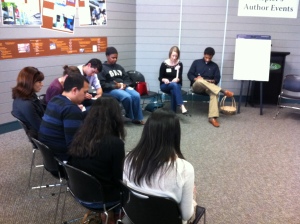Last fall I was fortunate to meet Greg Klein, Director of Blended Learning at Downtown College Prep in San Jose, and got a chance to see one of the few truly blended learning schools in the Bay Area. Greg manages his lab as a startup, piloting a variety of software programs giving himself and his students a chance to test it all out before integrating it fully into their workflow. As the first guest speaker at my Teacher Tech Talk event, Greg gave us all a deeper look into the tools he uses and some of the key decisions he’s made to cultivate an engaging and highly academic blended learning environment.
It helps to start with a deeper understanding of the student population. Downtown College Prep (DCP) in Alum Rock is located in one of the lowest income communities in San Jose. Greg’s campus serves 180 students (6th and 7th graders) of which 89% are on free/reduced lunch, however, 2/3 of the students d0 have access to internet at home. 60 students at a time spend 90 min/day in the learning lab going through 3 30-min rotations. The computers are setup in rows with a simple system of using red/green plastic cups to identify student progress and who may need some additional support. Greg went on to share the pretty comprehensive list of tools he uses to structure the content and delivery during those rotation sessions.
Greg and the DCP Team are currently experimenting with these products in the following areas, although many of them can be used in other content areas, too.
A student and instructor favorite, Quizlet, is in the process of launching a beta version of a new product, Sentencer, that allows kids to collaboratively create sentences and then vote up/down their writings. One of the obvious gaps was software tools to support science instruction and project-based learning (PBL,) and DCP currently uses Google Docs through Edmodo to deliver lesson plans that the teachers themselves created.
In generating this list during the discussion, a teacher made an interesting point wondering if students then had 11 different logins to manage these systems? While a Google Apps login is shared across a few of the tools, there are still several different logins that students have to remember and enter on a daily basis. This tied directly into an early suggestion on the need for unification of tools/systems to make it easier for students and teachers to use and access data from these different platforms.
Special thanks to Greg for being our first guest speaker and sharing these insights from the blended learning environment he’s creating at DCP. Keep an eye out for similar deep-dives as I plan to connect with the blended learning folks at SF Flex Academy and Rocketship sometime soon.

